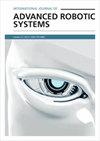Path planning of a mobile robot using an improved mixed-method of potential field and wall following
IF 2.1
4区 计算机科学
Q2 Computer Science
International Journal of Advanced Robotic Systems
Pub Date : 2023-05-01
DOI:10.1177/17298806231169186
引用次数: 0
Abstract
The existing Bug algorithms, which are the same as wall-following algorithms, offer good performance in solving local minimum problems caused by potential fields. However, because of the odometer drift that occurs in actual environments, the performance of the paths planned by these algorithms is significantly worse in actual environments than in simulated environments. To address this issue, this article proposes a new Bug algorithm. The proposed algorithm contains a potential field function that is based on the relative velocity, which enables the potential field method to be extended to dynamic scenarios. Using the cumulative changes in the internal and external angles and the reset point of the robot during the wall-following process, the condition for state switching has been redesigned. This improvement not only solves the problem of position estimation deviation caused by odometer noise but also enhances the decision-making ability of the robot. The simulation results demonstrate that the proposed algorithm is simpler and more efficient than existing wall-following algorithms and can realise path planning in an unknown dynamic environment. The experimental results for the Kobuki robot further validate the effectiveness of the proposed algorithm.基于改进的势场与壁面跟随混合法的移动机器人路径规划
现有的Bug算法与墙跟随算法相同,在解决由势场引起的局部极小问题方面具有良好的性能。然而,由于实际环境中发生的里程计漂移,这些算法规划的路径在实际环境中的性能明显比在模拟环境中差。为了解决这个问题,本文提出了一种新的Bug算法。所提出的算法包含一个基于相对速度的势场函数,这使得势场方法能够扩展到动态场景。利用壁跟随过程中机器人内外角和重置点的累积变化,重新设计了状态切换的条件。这种改进不仅解决了里程计噪声引起的位置估计偏差问题,而且提高了机器人的决策能力。仿真结果表明,该算法比现有的跟墙算法更简单、更高效,可以实现未知动态环境下的路径规划。Kobuki机器人的实验结果进一步验证了该算法的有效性。
本文章由计算机程序翻译,如有差异,请以英文原文为准。
求助全文
约1分钟内获得全文
求助全文
来源期刊
CiteScore
6.50
自引率
0.00%
发文量
65
审稿时长
6 months
期刊介绍:
International Journal of Advanced Robotic Systems (IJARS) is a JCR ranked, peer-reviewed open access journal covering the full spectrum of robotics research. The journal is addressed to both practicing professionals and researchers in the field of robotics and its specialty areas. IJARS features fourteen topic areas each headed by a Topic Editor-in-Chief, integrating all aspects of research in robotics under the journal''s domain.

 求助内容:
求助内容: 应助结果提醒方式:
应助结果提醒方式:


